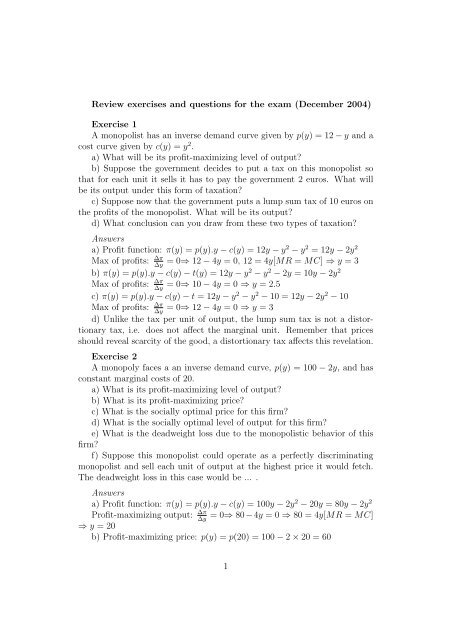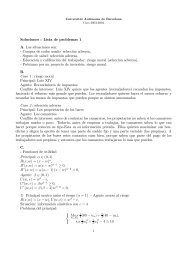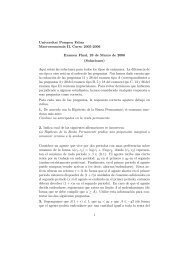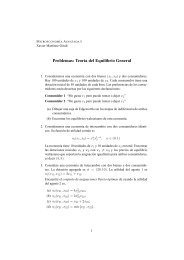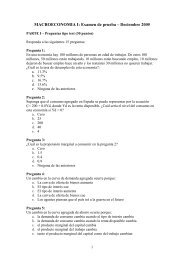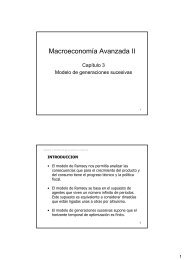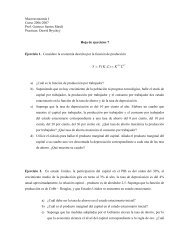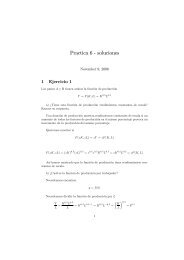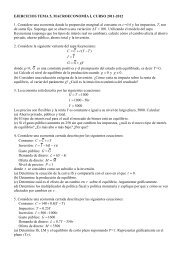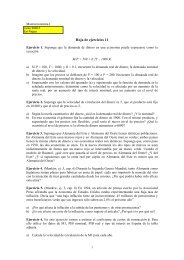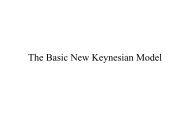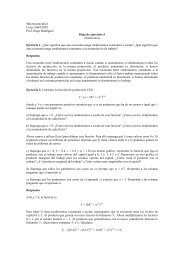Exercise 1 A monopolist has an inverse demand curve given ... - IDEA
Exercise 1 A monopolist has an inverse demand curve given ... - IDEA
Exercise 1 A monopolist has an inverse demand curve given ... - IDEA
You also want an ePaper? Increase the reach of your titles
YUMPU automatically turns print PDFs into web optimized ePapers that Google loves.
Review exercises <strong>an</strong>d questions for the exam (December 2004)<br />
<strong>Exercise</strong> 1<br />
A <strong>monopolist</strong> <strong>has</strong> <strong>an</strong> <strong>inverse</strong> dem<strong>an</strong>d <strong>curve</strong> <strong>given</strong> by p(y) = 12 − y <strong>an</strong>d a<br />
cost <strong>curve</strong> <strong>given</strong> by c(y) = y 2 .<br />
a) What will be its profit-maximizing level of output<br />
b) Suppose the government decides to put a tax on this <strong>monopolist</strong> so<br />
that for each unit it sells it <strong>has</strong> to pay the government 2 euros. What will<br />
be its output under this form of taxation<br />
c) Suppose now that the government puts a lump sum tax of 10 euros on<br />
the profits of the <strong>monopolist</strong>. What will be its output<br />
d) What conclusion c<strong>an</strong> you draw from these two types of taxation<br />
Answers<br />
a) Profit function: π(y) = p(y).y − c(y) = 12y − y 2 − y 2 = 12y − 2y 2<br />
Max of profits: ∆π = 0⇒ 12 − 4y = 0, 12 = 4y[MR = MC] ⇒ y = 3<br />
∆y<br />
b) π(y) = p(y).y − c(y) − t(y) = 12y − y 2 − y 2 − 2y = 10y − 2y 2<br />
Max of profits: ∆π = 0⇒ 10 − 4y = 0 ⇒ y = 2.5<br />
∆y<br />
c) π(y) = p(y).y − c(y) − t = 12y − y 2 − y 2 − 10 = 12y − 2y 2 − 10<br />
Max of profits: ∆π = 0⇒ 12 − 4y = 0 ⇒ y = 3<br />
∆y<br />
d) Unlike the tax per unit of output, the lump sum tax is not a distortionary<br />
tax, i.e. does not affect the marginal unit. Remember that prices<br />
should reveal scarcity of the good, a distortionary tax affects this revelation.<br />
<strong>Exercise</strong> 2<br />
A monopoly faces a <strong>an</strong> <strong>inverse</strong> dem<strong>an</strong>d <strong>curve</strong>, p(y) = 100 − 2y, <strong>an</strong>d <strong>has</strong><br />
const<strong>an</strong>t marginal costs of 20.<br />
a) What is its profit-maximizing level of output<br />
b) What is its profit-maximizing price<br />
c) What is the socially optimal price for this firm<br />
d) What is the socially optimal level of output for this firm<br />
e) What is the deadweight loss due to the <strong>monopolist</strong>ic behavior of this<br />
firm<br />
f) Suppose this <strong>monopolist</strong> could operate as a perfectly discriminating<br />
<strong>monopolist</strong> <strong>an</strong>d sell each unit of output at the highest price it would fetch.<br />
The deadweight loss in this case would be ... .<br />
Answers<br />
a) Profit function: π(y) = p(y).y − c(y) = 100y − 2y 2 − 20y = 80y − 2y 2<br />
Profit-maximizing output: ∆π = 0⇒ 80 − 4y = 0 ⇒ 80 = 4y[MR = MC]<br />
∆y<br />
⇒ y = 20<br />
b) Profit-maximizing price: p(y) = p(20) = 100 − 2 × 20 = 60<br />
1
c) Socially optimal price: p = MC ⇒ p = 20<br />
d) Socially optimal output: 20 = 100 − 2y ⇒ y = 40<br />
e) deadweight loss: 1(p 2 M −p C )×(y C −y M ) = 0.5(60−20)×(40−20) = 400.<br />
The deadweight loss is 400 euros.<br />
f) Perfect discrimination deadweight loss: 0. Remember that perfect<br />
discrimination me<strong>an</strong>s that the <strong>monopolist</strong> charges a price for each consumer<br />
<strong>an</strong>d charges at the highest willingness to pay of the consumer. He produces<br />
a level of output up to a point where the price is equal to the marginal cost<br />
as in the competitive case, all the surplus going to the <strong>monopolist</strong>. At the<br />
marginal point he sells to the consumer who <strong>has</strong> the lowest willingness to pay,<br />
there is no surplus made on this consumer. In the competitive case, there is<br />
a unique price for all the consumers. At this unique price, some consumers<br />
are happy because they would be willing to pay more for the good. The<br />
producer loses the surplus to the benefit of those consumers.<br />
<strong>Exercise</strong> 3<br />
Consider a market for a homogeneous good with two firms <strong>an</strong>d dem<strong>an</strong>d<br />
function:<br />
Y = 30 − 3p (1)<br />
where Y = y 1 + y 2 . Suppose the firms have the following cost functions:<br />
C(y 1 ) = 3y 1<br />
C(y 2 ) = 4y 2<br />
a) Suppose the two firms engage in Cournot competition. Find the two<br />
reaction functions <strong>an</strong>d graph them.<br />
b) Find the equilibrium price, the qu<strong>an</strong>tities produced by each firm as<br />
well as each firm’s profits.<br />
c) Suppose the two firms engage in Stackelberg competition, where firm 1<br />
acts first <strong>an</strong>d firm 2 acts when firm 1 qu<strong>an</strong>tity is known. Find the equilibrium<br />
price, the qu<strong>an</strong>tities produced <strong>an</strong>d each firm’s profits.<br />
d) Suppose the two firms engage in Bertr<strong>an</strong>d competition. Find the<br />
equilibrium price of each firm, as well as qu<strong>an</strong>tities produced <strong>an</strong>d profits.<br />
e) Suppose the two firms form a cartel <strong>an</strong>d maximize joint profits. Find<br />
the equilibrium price <strong>an</strong>d the qu<strong>an</strong>tities produced by each firm.<br />
Answers<br />
a)Y = 30 − 3p ⇒ y 1 + y 2 = 30 − 3p ⇒ p = 10 − 1(y 3 1 + y 2 )<br />
profit function π 1 (y 1 , y2) e = p(y 1 +y2)y e 1 −C(y 1 ) = [10− 1(y 3 1 +y2)]y e 1 −3y 1<br />
⇒ π 1 (y 1 , y2) e = 7y 1 − 1 3 y2 1 − 1y 3 1y2<br />
e<br />
Profit-maximizing output: ∆π 1(y 1 ,y2 e)<br />
∆y 1<br />
= 0 ⇒ 7 − 2y 3 1 − 1 3 ye 2 = 0<br />
Reaction <strong>curve</strong>: y 1 = 10.5 − 0.5y2<br />
e<br />
2
profit function π 2 (y1, e y 2 ) = p(y1 e +y 2 )y 2 −C(y 2 ) = [10− 1 3 (ye 1 +y 2 )]y 2 −4y 2<br />
⇒ π 2 (y1, e y 2 ) = 6y 2 − 1 3 y2 2 − 1 3 ye 1y 2<br />
Profit-maximizing output: ∆π 2(y 1 ,y2 e)<br />
∆y 2<br />
= 0 ⇒ 6 − 2y 3 2 − 1 3 ye 1 = 0<br />
Reaction <strong>curve</strong>: y 2 = 9 − 0.5y1<br />
e<br />
b) y 2 = 9 − 0.5y 1 y 1 = 10.5 − 0.5y 2<br />
y 2 = 5 y 1 = 8<br />
y 1 + y 2 = 30 − 3p ⇒ 5 + 8 = 30 − 3p ⇒ p = 5.66<br />
π 1 = 21, 3<br />
π 2 = 8.3<br />
c) Firm 1 is the leader. Its profit function:<br />
π 1 (y 1 , y 2 ) = p(y 1 + y 2 )y 1 − C(y 1 ) = [10 − 1 3 (y 1 + y 2 )]y 1 − 3y 1 = 7y 1 − 1 3 y2 1 −<br />
1<br />
y 3 1y 2 ,<br />
<strong>an</strong>d the reaction <strong>curve</strong> of firm 2 is: y 2 = 9 − 0.5y 1 .<br />
Substituting it into the profit function of firm 1:<br />
π 1 (y 1 , y 2 ) = 7y 1 − 1 3 y2 1 − 1y 3 1(9 − 0.5y 1 ) = 4y 1 − 1 6 y2 1<br />
Max of profit: ∆π 1<br />
∆y 1<br />
= 0 ⇒ 4 − 1 3 y 1 = 0<br />
y 1 = 12<br />
Plugging it into the reaction <strong>curve</strong> of firm 2:<br />
y 2 = 9 − 0.5 ∗ 12 = 3<br />
Equilibrium price: p = 10 − 1 3 (y 1 + y 2 ) = 10 − 4 − 1 = 5<br />
π 1 = 24<br />
π 2 = 3<br />
d) Bertr<strong>an</strong>d competition:<br />
price=marginal cost. For firm 1, p = 3 <strong>an</strong>d for firm 2, p = 4. The<br />
equilibrium price will be p = 3.99 <strong>an</strong>d the firm 1 will get all the dem<strong>an</strong>d,<br />
since at this price firm 2 is not profitable:<br />
y 2 = 0<br />
y 1 = Y = 30 − 3p = 30 − 3 × 3.99 = 18.03<br />
π 1 = 3.99 × 18.03 − 3 × 18.03 = 17.85<br />
e) The profit maximization of a cartel is to maximize joint profits:<br />
The profit maximization of a cartel is to maximize joint profits:<br />
profit function:<br />
π(y 1 , y 2 ) = p(y 1 + y 2 )[y 1 + y 2 ] − c(y 1 ) − c(y 2 )<br />
= [10 − 1 3 (y 1 + y 2 )][y 1 + y 2 ] − 3y 1 − 4y 2<br />
= 10(y 1 + y 2 ) − 1 3 (y 1 + y 2 ) 2 − 3y 1 − 4y 2<br />
3
∆π(y 1 ,y 2 )<br />
∆(y 1 +y 2 ) = 0 ⇒ 10 − 2 3 y 1 − 2 3 y 2 − 3 = 0 ⇒ y 1 + y 2 = 21 2<br />
∆π(y 1 ,y 2 )<br />
= 0 ⇒ 10 − 2y ∆(y 1 +y 2 ) 3 2 − 2y 3 1 − 4 = 0 ⇒ y 1 + y 2 = 9<br />
Therefore, only firm 1 will produce a qu<strong>an</strong>tity of 10.5. Firm 2 will close<br />
down.<br />
p = 10 − 1(y 3 1 + y 2 ) = 10 − 1 (10.5) = 6.5.<br />
3<br />
<strong>Exercise</strong> 4<br />
Answer T (True) or F (False):<br />
1/ The point where (x 2 1, x 2 2) where MRS=2 <strong>an</strong>d MRT=1 is not efficient because<br />
both consumers could be made better off by increasing the production<br />
of good 1. [True]<br />
2/ Two firms form a cartel. Then, the firm producing more th<strong>an</strong> the<br />
other one does not have incentives to deviate from the equilibrium. [False]<br />
3/ When there is a <strong>monopolist</strong> in a market, the production level is lower<br />
th<strong>an</strong> in the case of perfect competition. [True]<br />
4/ When a <strong>monopolist</strong> is charged a tax, she tr<strong>an</strong>sfers half of it to consumers.<br />
[False]<br />
5/ A <strong>monopolist</strong> that c<strong>an</strong> discriminate perfectly will extract all of consumer’s<br />
surplus. [True]<br />
6/ Equal division is always fair. [False] [Remember: A fair allocation is<br />
equitable <strong>an</strong>d Pareto efficient].<br />
7/ You like v<strong>an</strong>illa ice cream. I move to your town <strong>an</strong>d dem<strong>an</strong>d so much<br />
v<strong>an</strong>illa ice cream that its price rises. This is <strong>an</strong> example of a negative externality<br />
from consumption. [False]<br />
8/ In <strong>an</strong> economy with production, where the technology exhibits const<strong>an</strong>t<br />
returns to scale, the Second Welfare Theorem of Welfare Economics<br />
holds. [True]<br />
9/ A <strong>monopolist</strong> charging where the elasticity of dem<strong>an</strong>d |ɛ| equals one<br />
is necessarily charging a perfectly competitive price. [False]<br />
10/ A firm creating negative production externalities typically produces<br />
more th<strong>an</strong> the efficient qu<strong>an</strong>tity. [True]<br />
<strong>Exercise</strong> 5: some topics to work...<br />
1/ Compare the shape of the dem<strong>an</strong>d <strong>curve</strong> for a competitive firm <strong>an</strong>d<br />
for a <strong>monopolist</strong>. Graph them. Explain the difference.<br />
A competitive firm faces a flat dem<strong>an</strong>d <strong>curve</strong> because its production,<br />
which is negligible in the aggregate supply, does not influence the price.<br />
4
Since it c<strong>an</strong>not influence the price, it does not affect the dem<strong>an</strong>d it faces.<br />
That’s why we say that the competitive firm faces a flat dem<strong>an</strong>d <strong>curve</strong>. For<br />
a <strong>monopolist</strong>ic firm, the dem<strong>an</strong>d <strong>curve</strong> is decreasing, because its production,<br />
i.e., its supply affects the price <strong>an</strong>d the dem<strong>an</strong>d for each corresponding<br />
price. If its supply decreases, the price increases. When the price increases,<br />
the dem<strong>an</strong>d decreases. That’s why we say that a <strong>monopolist</strong>ic firm faces a<br />
decreasing dem<strong>an</strong>d <strong>curve</strong>.<br />
2/ What is the markup<br />
The markup is the difference between the price of one unit of the good<br />
<strong>an</strong>d its marginal cost. Under perfect competition, the markup is 0.<br />
3/ Explain the situation of a natural monopoly.<br />
A natural monopoly occurs when a firm c<strong>an</strong>not operate at <strong>an</strong> efficient<br />
level of output without losing money.<br />
4/ What is a monopsonist Why will hire <strong>an</strong> inefficiently small amount<br />
of the factor of production<br />
5/ Why a cartel is unstable<br />
6/ What does general equilibrium me<strong>an</strong><br />
GE refers to the study of how the economy c<strong>an</strong> adjust to have dem<strong>an</strong>d<br />
equal supply in all markets at the same time.<br />
7/ Explain what Pareto efficiency me<strong>an</strong>s<br />
A Pareto efficient allocation is one in which there is no feasible reallocation<br />
of the goods that would make all consumers at least as well-off <strong>an</strong>d at least<br />
one consumer strictly better off.<br />
7bis/ Walras’law states that the value of aggregate excess dem<strong>an</strong>d is zero<br />
for all prices.<br />
8/ The First Welfare Theorem states that a competitive equilibrium is<br />
Pareto efficient.<br />
9/ The Second Welfare Theorem states that as long as preferences are<br />
convex, then every Pareto efficient allocation c<strong>an</strong> be supported as a competitive<br />
equilibrium.<br />
10/ In <strong>an</strong> competitive economy with production, Pareto efficiency requires<br />
that each individual’s marginal rate of substitution be equal to the marginal<br />
rate of tr<strong>an</strong>sformation.<br />
11/ Arrow’s impossibility theorem shows that there is no ideal way to<br />
aggregate individual preferences into social preferences.<br />
5
12/ As long as the welfare function is increasing in each individual’s utility,<br />
a welfare maximum will be Pareto efficient. Furthermore, every Pareto<br />
efficient allocation c<strong>an</strong> be thought of as maximizing some welfare function.<br />
13/ If externalities are present, the outcome of a competitive equilibrium<br />
market is unlikely to be Pareto efficient.<br />
<strong>Exercise</strong> 6<br />
Consider a pure exch<strong>an</strong>ge economy with two goods (1 <strong>an</strong>d 2) <strong>an</strong>d two<br />
consumers (A <strong>an</strong>d B) whose utility functions <strong>an</strong>d initial endowments are<br />
<strong>given</strong> by:<br />
U A (x 1 , x 2 ) = √ x 1 + x 2 , w A = (3, 7)<br />
U B (x 1 , x 2 ) = x 1 + 2x 2 , w B = (2, 4)<br />
a) Find all the Pareto-efficient allocations (Contract <strong>curve</strong>).<br />
b) Consider good 1 as the numéraire (p 1 = 1), what is the equilibrium<br />
price of good 2 Find the equilibrium allocation.<br />
c) Is the equilibrium a fair allocation<br />
d) Find the fair allocations.<br />
Answers<br />
a) Any Pareto efficient allocation must satisfy: MRS A = MRS B <strong>an</strong>d the<br />
following feasibility conditions:<br />
x A 1 + x B 1 = w1 A + w1 B = 3 + 2 = 5<br />
x A 2 + x B 2 = w2 A + w2 B = 7 + 4 = 11<br />
MRS A =<br />
√<br />
1/(2<br />
x A 1 )<br />
[<br />
∂U A /∂x A 1<br />
∂U A /∂x A 2<br />
= 1/(2 √<br />
]<br />
x A 1 )<br />
1<br />
=<br />
[<br />
]<br />
1<br />
= ∂U B /∂x B 1<br />
= MRS<br />
2 ∂U B /∂x B B<br />
2<br />
= 1 ⇒ 1 2 xA 1 = 1<br />
The contract <strong>curve</strong> (the set of Pareto efficient allocations) is <strong>given</strong> by<br />
x 1 = 1 (This is a straight vertical line in the Edgeworth box). The Pareto<br />
set is P = { (x A 1 , x A 2 ); x A 1 = 1 }<br />
We know that MRS A = MRS B = p 1<br />
p 2<br />
Since p 1<br />
p 2<br />
= 1 <strong>an</strong>d p 2 1 = 1, then p 2 must be equal to 2. There is only one<br />
couple of prices (p 1 , p 2 ) that leads to Pareto efficiency.<br />
b) Consumer A’s problem √<br />
max U A (x A 1 , x A 2 ) = x A 1 + x A 2<br />
subject to p 1 x A 1 + p 2 x A 2 = m A (with p 1 = 1 <strong>an</strong>d m A = 3 + 7p 2 )<br />
6
B:<br />
√<br />
L = x A 1 + x A 2 − λ(x A 1 + p 2 x A 2 − m A )<br />
∂L<br />
∂x A 1<br />
∂L<br />
∂x A 2<br />
1<br />
2<br />
√<br />
√<br />
= 1<br />
2 x A 1<br />
x A 1<br />
− λ = 0<br />
= 1 − λp 2 = 0<br />
= 1 2 ⇒ xA 1 = 1 4 p2 2<br />
Substituting it into the budget constraint x A 1 + p 2 x A 2 = 3 + 7p 2 :<br />
1<br />
4 p2 2 + p 2 x A 2 = 3 + 7p 2 ⇒ x A 2 = 7 + 3 p 2<br />
− 1 4 p 2<br />
Since p 2 = 2, x A 2 = 6.5<br />
Using the feasibility conditions, we c<strong>an</strong> find the allocation for consumer<br />
x A 1 + x B 1 = 5 ⇒ x B 1 = 5 − 1 = 4<br />
x A 2 + x B 2 = 11 ⇒ x B 2 = 11 − 6.5 = 4.5<br />
The equilibrium allocation is A(1; 6.5) <strong>an</strong>d B(4; 4.5).<br />
c) Is this allocation fair<br />
A fair allocation is equitable <strong>an</strong>d Pareto efficient. We already know that<br />
the allocation is Pareto efficient. Now, let’s check if it is equitable. To do so<br />
we see if A envies B <strong>an</strong>d vice versa.<br />
Consumer A : with his own allocation : U A (1, 6.5) = √ 1 + 6.5 = 7.5<br />
with B’s allocation: U A (4, 4.5) = √ 4 + 4.5 = 6.5<br />
Consumer A does not envy B.<br />
Consumer B : with his own allocation : U B (4, 4.5) = 4 + 9 = 13<br />
with A’s allocation: U B (1, 6.5) = 1 + 13 = 14<br />
Consumer B envies A. Therefore, the allocation is not equitable. So, this<br />
is not a fair allocation.<br />
d) There is no fair allocation. Since there is only one couple of prices<br />
leading to Pareto efficiency <strong>an</strong>d this allocation is not fair, there is no fair<br />
allocation with these types of preferences <strong>an</strong>d resource constraints.<br />
<strong>Exercise</strong> 7<br />
BCN Sports is a new sports club in Barcelona. A recent study shows that<br />
the dem<strong>an</strong>d (in hours) is p M = 16 − q M for men <strong>an</strong>d p W = 10 − q W /2 for<br />
women. BCN Sports <strong>has</strong> o cost function <strong>given</strong> by:<br />
C(q) = 2q (2)<br />
a) Suppose that Jo<strong>an</strong>, who owns BCN Sports, w<strong>an</strong>ts to charge only price<br />
per hour both for women <strong>an</strong>d men. What would that price be How m<strong>an</strong>y<br />
hours would be dem<strong>an</strong>ded What would BCN Sports’ profits be<br />
7
) Jo<strong>an</strong>’s nephew courses ADE/ECO at UPF <strong>an</strong>d argues that <strong>given</strong> their<br />
different dem<strong>an</strong>ds, the two groups should be charged different prices. In this<br />
case, what prices would he charge for men <strong>an</strong>d women How m<strong>an</strong>y hours<br />
would be dem<strong>an</strong>ded by each group What would BCN Sports’profits be<br />
c) Jo<strong>an</strong>’s niece also courses ADE/ECO at UP <strong>an</strong>d she suggests him to<br />
charge <strong>an</strong> entry fee in addition to the charge per hour. What prices would<br />
he charge as entry <strong>an</strong>d per hour for each group How m<strong>an</strong>y hours would be<br />
dem<strong>an</strong>ded in each group What would BCN Sports’ profit would be<br />
d) What option (among a), b) <strong>an</strong>d c)) would Jo<strong>an</strong> prefer What about<br />
the men What about the women Explain.<br />
Answers<br />
a) q M = 16 − p M <strong>an</strong>d q W = 20 − 2p W<br />
q M + q W = q = 36 − 3p ⇒ p = 12 − q 3<br />
π = 10q − 1 3 q2<br />
∆π<br />
∆q = 10 − 2 3 q = 0 ⇒ q = 15<br />
p = 12 − 1 3 q ⇒ p = 7<br />
π = pq − cq = 75<br />
b) π M = p M q M − 2q M = (16 − q M )q M − 2q M = 14q M − q 2 M<br />
∆π M<br />
∆q M<br />
= 14 − 2q M = 0 ⇒ q M = 7<br />
p M = 16 − 7 = 9<br />
π W = p W q W − 2q W = 8q W − 1 2 q2 W<br />
∆π W<br />
∆q W<br />
= 8 − q W = 0 ⇒ q W = 8<br />
p W = 10 − 4 = 6<br />
π = π M + π W = 9 ∗ 7 − 2 ∗ 7 + 6 ∗ 8 − 2 ∗ 8 = 81<br />
c) p∗ = MC = 2<br />
q M = 16 − 2 = 14 ⇒ F M = 1 (16 − 2) ∗ 14 = 98 (surface of a tri<strong>an</strong>gle<br />
2<br />
= 1 × height × base)<br />
2<br />
q W = 10 − 2 = 8 ⇒ F W = 1 (10 − 2) ∗ 16 = 64<br />
2<br />
Profits=consumers’surplus + profits per hour. But profits per hour=0<br />
(since p = MC). Therefore:<br />
π M = 98<br />
π W = 64<br />
π = π M + π W = 98 + 64 = 162<br />
d) which is the best option<br />
From the table, it is straightforward to see that the option c) is the best<br />
for the firm. For the men, it is a) <strong>an</strong>d for the women it is b).<br />
8
Pricing strategy a) Pricing strategy b) Pricing strategy c)<br />
Men p M = 7 p M = 9 F M = 98 <strong>an</strong>d p M = 2<br />
Women p W = 7 p W = 6 F W = 64 <strong>an</strong>d p W = 2<br />
Profits 75 81 162<br />
of the firm<br />
<strong>Exercise</strong> 8<br />
The fishermen of a village on the Valencia’s coast are fishing sardines.<br />
The production of sardines depends on the number of fishing boats <strong>an</strong>d is<br />
<strong>given</strong> by the function:<br />
S = 1500b − 5b 2 (3)<br />
where b is the number of fishing boats <strong>an</strong>d S is the production (in kilos)<br />
of sardines. Each boat <strong>has</strong> a cost of 1000 euros <strong>an</strong>d the price of 1 kilo of<br />
sardines is 2 euros.<br />
a) If the fishermen decide to divide equally among themselves the profits<br />
from their production of fish, how m<strong>an</strong>y boats will they use for fishing<br />
b) If the council of the village w<strong>an</strong>ts to maximize the profits from fishing<br />
of the village <strong>an</strong>d c<strong>an</strong> decide the number of fishing boats, how m<strong>an</strong>y boats<br />
will be allowed<br />
c) In which situation will the qu<strong>an</strong>tity be higher Why is so Which<br />
situation leads to the efficient production of fish Explain.<br />
Answers<br />
a) Value of the production = 2S b<br />
Production takes place up to the point: 2S b<br />
= 1000<br />
2(1500b−5b 2 )<br />
b<br />
= 1000 ⇒ b = 200<br />
S = 1500 × 200 − 5 × (200 2 ) = 300000 − 200000 = 100000<br />
b) π = p × S − c × b = 2(1500b − 5b 2 ) − 1000b<br />
∆π<br />
= 2000 − 20b = 0 ⇒ b = 100<br />
∆b<br />
S = 1500 × 100 − 5(100 2 ) = 150000 − 50000 = 100000<br />
c) The qu<strong>an</strong>tity produced is the same. In the first situation, the addition<br />
of a boat is still profitable but does not take into account the reduction of<br />
the output per boat it will cause due to the limitation of resources. The<br />
social cost is ignored in the first situation. In the second situation, the true<br />
cost is taken into account <strong>an</strong>d leads to a smaller number of boat. This is the<br />
efficient production of fish.<br />
9
Buena suerte...<br />
10


